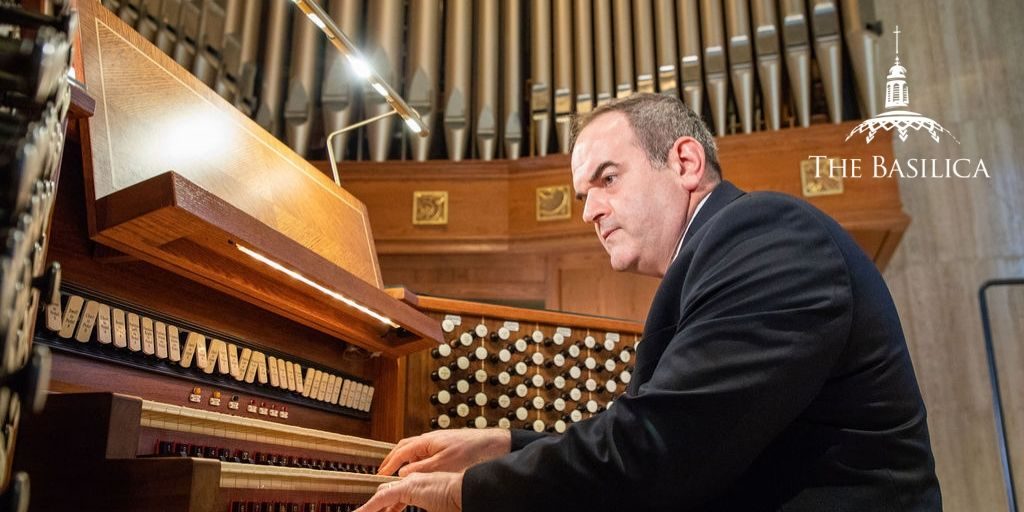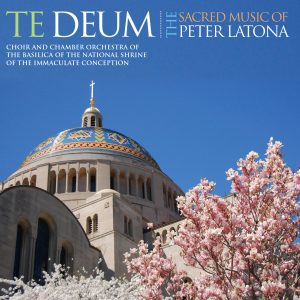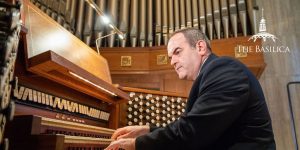
The musicians of the Basilica strive to transform hearts and minds through the power and beauty of sacred music in the Roman Catholic Liturgy. They are guided by the belief that inspired liturgy leads to a transformation, deepening and awakening one’s faith. To share insight into how this beautiful vision is made a reality, Dr. Peter Latona, Music Director for the National Shrine, speaks about his experience.
Today, Dr. Latona takes us behind the scenes, sharing his experiences as a composer at the Basilica, and exploring what it is like to write music for the largest Catholic Church in North America.
This post is Part II in a series. View Part I, Part III, and Part IV.
*****

As a composer, how would you describe your compositional style? When you write liturgical music, and music for the Basilica in particular, what principles do you keep in mind?
That’s a somewhat difficult question to answer simply because I tend to write in a variety of styles with the intention of providing what I believe best fits a particular need. I suppose you can say that my Psalm settings, gospel verses, and congregational settings tend to be modal in character and rhythmically flexible with groupings of twos and threes as opposed to a set, unchanging meter. I also am careful to ensure that they can be sung successfully by the ensemble.
The more elaborate compositions have a harmonic language which grows out of my affinity for early twentieth century French composers. Having said that, I’ve written pieces that sound like Distler, Bach, Messiaen, Langlais, MacMillian, Part, and others. In each instance, I’m looking for a harmonic language or style that best communicates the expressive qualities, mood, or atmosphere that I think best fits the moment in a particular Liturgy.
Ultimately, I aim to compose music with expressive qualities and emotional content that are on point for a given moment in the Liturgy, that is the appropriate duration, and that can be executed successfully by those performing it (be it professional musicians, congregations, etc.), and with the instruments and acoustics on hand.
Which of your compositions is your favorite?
That’s a bit like asking a parent to pick their favorite child. Those for which I have received the most positive feedback would be the Mandatum, Agnus Dei Tropes on the Resurrection, Introit: Priests of God/Servants of God as well as a triptych I was commissioned to write for the 100th Anniversary of Armistice called Saints Triumphant, scored for SATB chorus, baritone solo and flugelhorn. If I had to choose one, I am particularly fond of the antiphon I composed for the dedication of the Trinity Dome mosaic. That antiphon, “Blessed are you O Virgin Mary” is relatively short but very evocative. An excerpt of the antiphon was used on the video featured on the Basilica website (included below).
Who are your favorite composers, and do any particular compositions have special meaning to you?
Another tough question but I can tell you that throughout my college years, I was absolutely crazy about Monteverdi’s 1610 Vespers of the Blessed Virgin Mary, Stravinsky’s Petrushka and Ralph Vaughan Williams’ Benedicite. I’m sure I’ve listened to each of those one hundred times and they still are very significant to me. While they are all completely different styles, I think it’s the very effective use of color, harmony and texture which draws me to these great works.
Dr. Peter Latona is the Director of Music for the Basilica of the National Shrine of the Immaculate Conception. View his full bio.
Many thanks to Bridgette Wargovich, Director of Music and Organist at Corpus Christi Parish in East Sandwich, MA, for conducting this interview with Peter Latona. Bridgette received her DMA in Organ Performance from Boston University and is dedicated to preserving and promoting the musical treasure of the Church.
We invite you to support the National Shrine Sacred Music Program.

